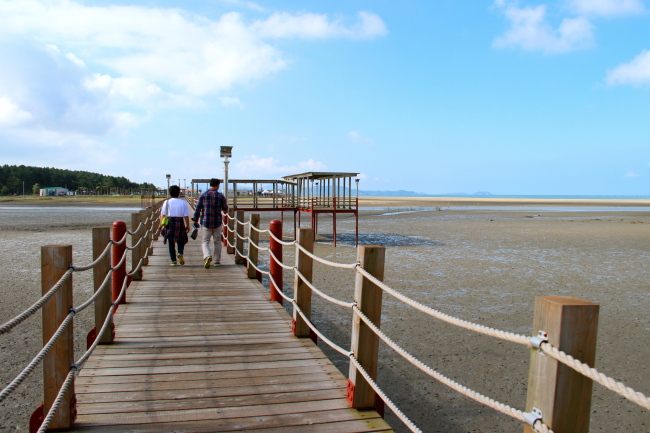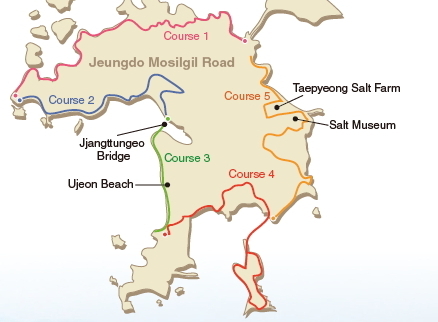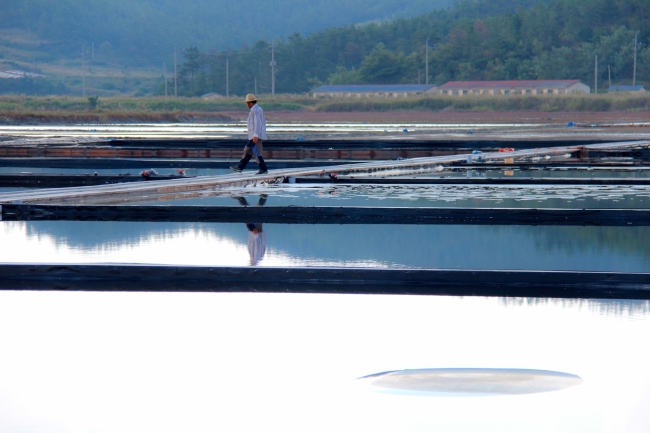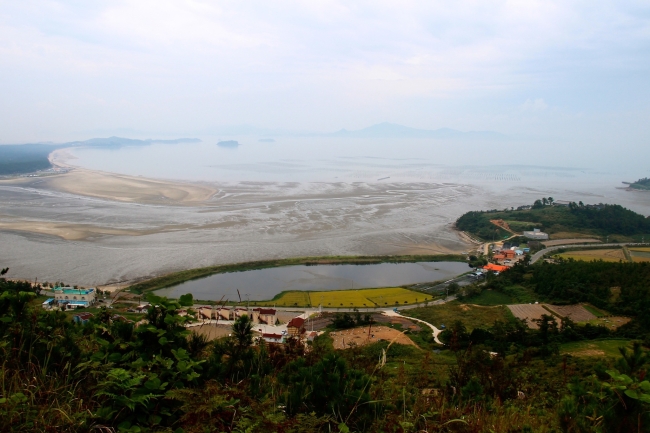 |
Visitors walk across the Jjangttungeo Bridge over mud flats on the southern coast of Jeungdo.
(Julie Jackson/The Korea Herald) |
This is the 10th installment in an 11-part series that introduces some of the best walking trails in Korea. Based on each trail’s popularity and the recommendations of travel experts and the Culture Ministry, The Korea Herald selected the 10 best places for walking and hiking. The series received funding from the Korea Press Foundation. ― Ed.
JEUNGDO, South Jeolla Province ― The first city in Asia to ever receive the “Slow City” title as part of the Cittaslow movement, the small island of Jeungdo is the embodiment of a largo-tempo lifestyle boasting some of the country’s most pristine coast, vast mud flats and picturesque farmlands that make it one of the most ideal walking destinations in the nation.
Located off the southwestern coast of the peninsula in Sinan County, South Jeolla Province, Jeungdo Island was designated in 2007 as an official member of the Cittaslow movement, a movement founded in Italy in October 1999. In keeping with the slow movement trend, the Cittaslow movement’s goals are to improve the quality of life in off-the-grid towns by slowing down the overall pace and atmosphere of a particular location.
After the island was put on the Cittaslow map, attempts were made to slightly revamp the once-hard-to-reach destination to be a bit more readily accessible for those who wish to escape city life and experience the true lethargies of a slow city.
“Although I think there are many great places to visit and many things to see and do here, I do not believe this area will become a destination that will be overrun with tourists,” said Kim Jung-sook, owner of the Everis Pension in Jeungdo Island. “When people do visit here, what they expect is what they get: a quiet, peaceful destination where people can come to relax.”
Jeungdo Island is the seventh largest of the more than 1,000 islands in the region and its virtually unpolluted environmental plains have made it an ideal ecological travel destination.
“The last thing I would ever want is for this island is to turn into some kind of overrun town filled with a ton of large buildings and our streets filled with traffic and crowds,” Kim continued. “It would defeat the purpose of people coming here and enjoying the true meaning of what it means to be a slow city.”
Jeungdo Mosilgil Road

The island’s one and only walking trail, the Jeungdo Mosilgil Road, is a 42.7-km trail divided into five courses, circling the entire island on the coastline and passing through a vast number of mud flats and beaches as well as the nation’s largest salt farming fields.
The five courses of the Mosilgil trail include:
Course 1: 10 km, takes roughly three hours to complete, and passes through a salt farming village and the island’s heart-shaped beach
Course 2: 7 km, takes about two hours to complete and passes through the northwestern coastal portion of the island
Course 3: 4.6 km, 1.5 hours to complete and visits the Jjangttungeo Bridge, the Thousand Year Pine Tree Forest and the Mud Flat Museum
Course 4: 10.3 km, three hours to complete, passes the small southern island of Hwado
 |
A local farmer tends to his salt at the Taepyeong Salt Farm in Jeungdo, South Jeolla Province.
(Julie Jackson/The Korea Herald) |
Course 5: 10.8 km, takes roughly three hours to complete, with the main attraction being the Taepyeong Salt Farm and the Salt Museum
The Mosilgil trail is one of the best options for those who wish to see the best that the island has to offer including Jeungdo’s biggest attractions such as the Jjangttungeo Bridge, the Salt Museum and the Taepyeong Salt Farm.
Jeungdo Island began to produce salt in the early 1950s; the island’s sea salt is harvested by hand and has a high mineral content adding to the taste. The island’s famous Taepyeong Salt Farm was first constructed in 1953 and is registered as cultural heritage item No. 360. Every year, around 15,000 tons of sea salt are harvested from these salt-cultivating farms.
The view of farmers tending to their salt fields in the early morning is a must for those looking for some picturesque and iconic snapshots. The Taepyeong Salt Farm is also a great destination to visit at sunset as the sun rays reflect off the clear water that covers each salt field.
Located right next to the Taepyeong Salt Farm is the island’s Salt Museum, where visitors can learn everything there is to know about salt and its history. Visitors can also experience the full effects of salt farming by participating in the museum’s salt harvesting program. This program is available to visitors during the salt harvest season from mid-March to mid-October. Those looking to participate in the hands-on program must book in advance, with prices listed at 7,000 won for those 19 years and older and 6,000 won for youths.
Another worthwhile attraction is the Jjangttungeo Bridge, located at the southern coast of the island. Jangttungeo, which is Korean for spotted mud hoppers, inhabit nearly every inch of the island’s mud flat areas. The bridge allows visitors to walk over the mud and marvel at the spectacular flats that stretch across the island’s coast as far as the eye can see. The bridge is also a wonderful way to fully witness Jeungdo Island’s environmental wonders with the abundance of mud hoppers and tiny crabs that roam all over the island’s mudflats.
“One of the best things about Jeungdo Island is, without a doubt, our beaches and our sunsets,” said Kim. “Because of our low pollution emissions, we are able to enjoy all of the island’s natural beauty and sea life.”
 |
A view of the vast mud flats and coastline of the island of Jeungdo, South Jeolla Province.
(Julie Jackson/The Korea Herald) |
Jeungdo eats
Similar to any coastal region, Jeungdo Island is well known for its seafood. Aside from the more obvious culinary delicacies from the sea, there are a number of establishments that use the flavors of the local sea salt to season the meals. The Salt Farm located right next to the Taepyeong Salt Farm and Salt Museum embraces the island’s claim to fame and offers its diners a taste of the sea by revamping a number of traditional Korean dishes.
Haecho bibimbap, or seaweed bibimbap, is a seaside twist on bibimbap that combines seaweed and fish roe, lemon and other assorted vegetables. The rice dish, served along with fried fish and tofu stew, has a very healthy and briny seaside taste.
For those taste bud adventurists looking to step outside the box, a trip to the local convenience store located next to the Salt Museum will allow one the unique experience of trying out the area’s salty take on classic soft ice cream.
With one’s choice of salt flavor toppings ranging from mango, strawberry and blueberry to green tea and chocolate, Jeungdo Island’s salt ice cream is surprisingly tasty ― once one’s taste buds understand that the salty kick is not a neurological miscommunication ― and is something that should not be missed.
By Julie Jackson (juliejackson@heraldcorp.com)